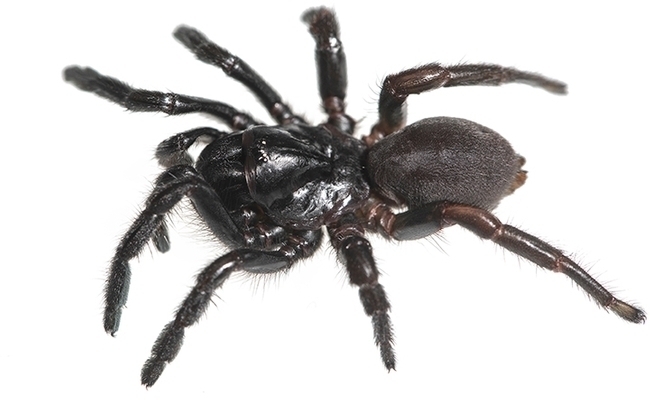- Author: Kathy Keatley Garvey
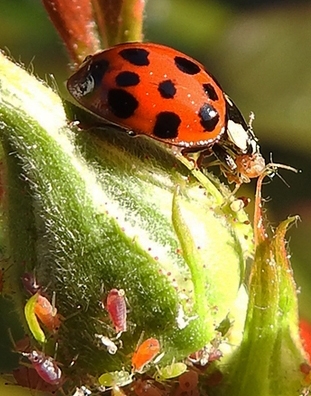
And well you should: honey bees are the global workhorses of the pollination community and pollinate about one-third of the food we eat, including fruits and vegetables and some nuts, primarily almonds (California's almond acreage exceeds 1.6 million.)
But to continue the alliteration--butterflies, bats, birds and beetles are pollinators, too.
That includes "the good guys and gals," the lady beetles, aka ladybugs, which devour aphids.
However, this is National Pollinator Week and a good time to reiterate that insects can be both pollinators and pests. Take the blister beetles (family Meloidae, which contains about 2500 species) are one color or striped. Blister beetles are a pest of alfalfa and many species secrete a poisonous chemical called cantharidin, which protects them from their predators but is quite toxic to livestock, especially horses.
According to the Alfalfa Pest Management Guidelines published by the UC Statewide Integrated Pest Management Program (UC IPM): “Blister beetles do not cause widespread feeding damage to alfalfa; however, they contain a chemical, cantharidin, which is toxic to livestock. Cantharidin is contained in the hemolymph (blood) of the beetles, and can contaminate forage directly, when beetles killed during harvest are incorporated into baled hay, or indirectly, by transfer of the hemolymph from crushed beetles onto forage. Horses are particularly susceptible to the toxic effects of cantharidin. Consuming as few as six beetles can kill a horse.”
A 2020 news story out of the Midwest related that beetle-infested hay purchased at an auction in South Dakota led to the deaths of 16 horses at a riding stable in Mauston, Wisconsin. Reporter Carleen Wild wrote that even a small amount of the bug itself or cantharidin "can be toxic enough to kill a horse within 72 hours." The horse owners reported what looked like "blisters and holes down their esophagus and throughout their insides."
The odorless, colorless chemical also blisters the human skin; physicians use it to remove warts.
That's one powerful chemical.

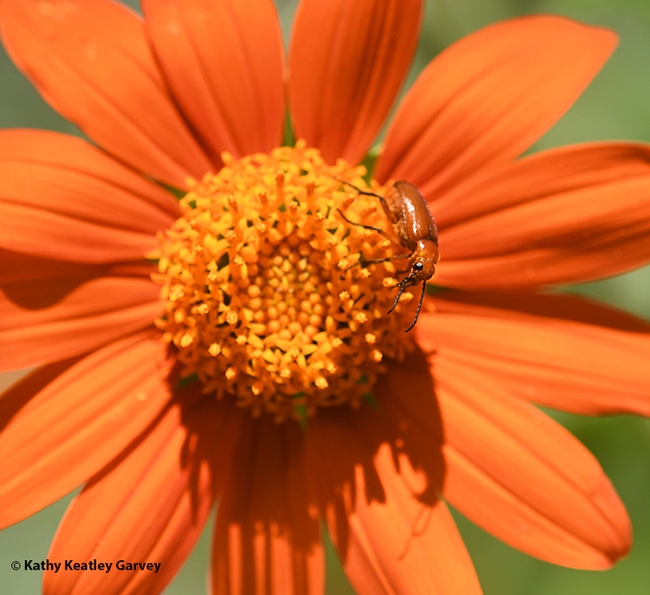
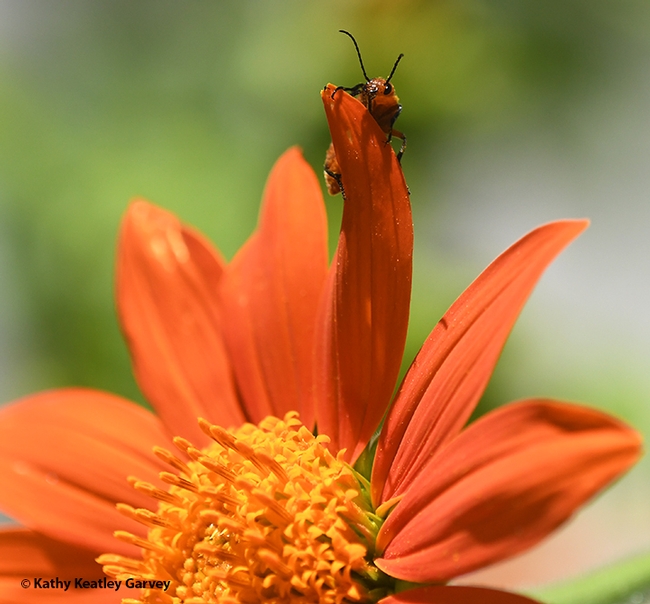
- Author: Kathy Keatley Garvey
It's Day 3 of National Pollinator Week.
Fortunately, a tiger came to visit us--no, not the predatory jungle animal, Panthera tigris, but a newly emerged Western tiger swallowtail, Papilio rutulus.
This native butterfly is quite colorful, with black stripes accenting its brilliant yellow wings, and blue and orange spots gracing its tail. When it flutters into your garden, you stop everything you're doing and become a professional butterfly watcher until it leaves. It's the law, I think. Anyway, Western tiger swallowtails are almost hypnotic.
This fluttering tiger took a liking to our Mexican sunflower, Tithonia rotundifola, and was totally unaware of a tiny longhorned bee, a male Melissodes agilis, heading straight for it.
Pretend you're the butterfly. Here you are, newly emerged and you've discovered a patch of Tithonia offering delicious nectar! Heaven scent! Then you see a speedy little critter targeting you. He's not about to make a lane change. There's no garden patrol to monitor his speed or aggressive behavior. He's coming for you. He aims to hit you and dislodge you from your perch.
This little bee, in fact, targets all critters occupying "his" flowers. He isn't out to sting the floral occupants, as one reader surmised. It's a male bee, and boy bees can't sting. Nor is he fighting over pollen. Males do not collect pollen or nectar for their colony--the females do.
So what is he doing? He's trying to protect or save the floral resources for the females of the species so he can mate with them. The late Robbin Thorp, noted bee expert and distinguished emeritus professor of entomology at UC Davis, used to talk about these little guys bullying all the floral tenants--from Valley carpenter bees to majestic monarchs to praying mantids. Sometimes an unfortunate Melissodes winds up in the spiked forelegs of a mantis. Or in the clutches of a spider. Or in the beak of a bird.
It's a jungle out there. Sometimes it's the survival of the fittest. Or the flittest.
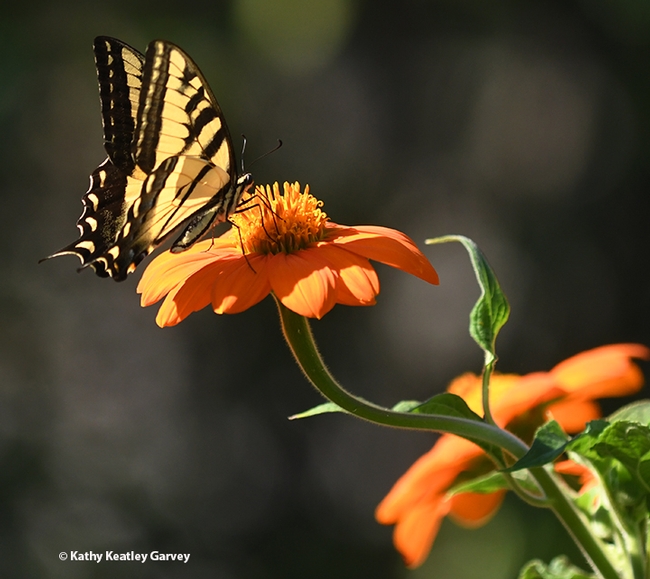
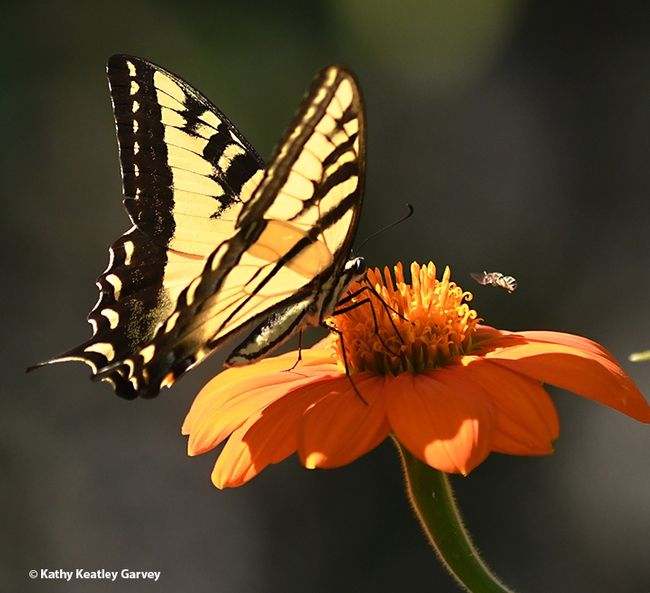
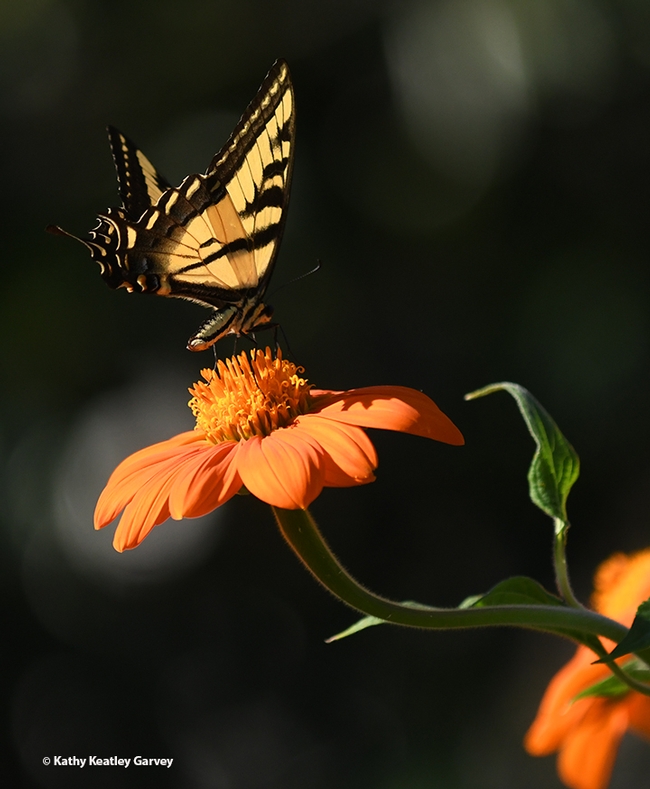
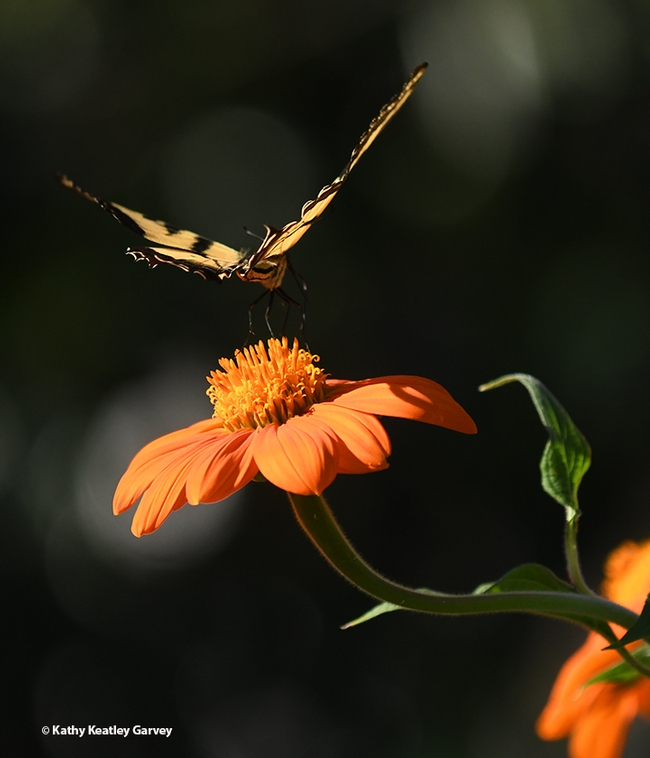
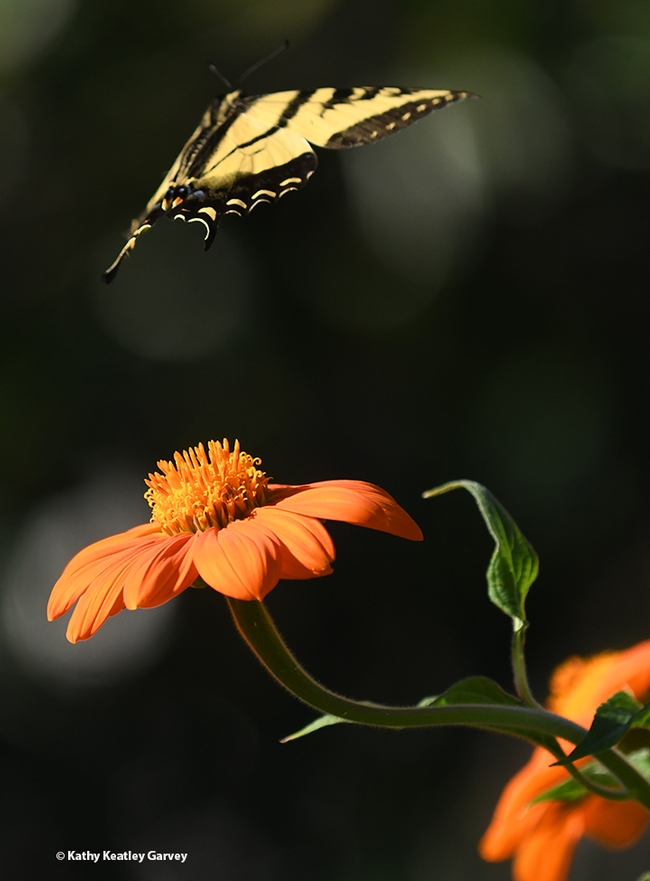
- Author: Kathy Keatley Garvey
It's Day 2 of National Pollinator Week.
So, I guess I should "toot my own horn" (we don't have one, but in our household we do have a piano, a double bass, a guitar, a banjo, a ukulele, a dulcimer, a harmonica, a sousaphone, a set of hand drums, and two accordions. Note that the last one to play the piano well was the...um...cat).
Yours truly of the UC Davis Department of Entomology and Nematology, just won a silver award or second-place honors, in a photography competition hosted by the international Association for Communication Excellence in Agriculture, Natural Resources and Life and Human Sciences (ACE). ACE announced the awards today (June 22) at its virtual conference.
To draw attention to the plight of monarchs, I captured (with a Canon MPE-65mm lens) an image of a monarch egg in our family's pollinator garden where we create habitat for assorted bees and butterflies and other pollinators.
“The purpose of my image is to draw attention to the dwindling monarch butterfly population,” I wrote on the form. “They are on life support.” The Xerces Society for Invertebrate Conservation's reports that overwintering monarchs have declined 99 percent in coastal California since the 1990s.
I posted the image at https://bit.ly/3cUx358 Aug. 10, 2020 on my daily (Monday-Friday) Bug Squad blog on the UC Agriculture and Natural Resources website.
Wrote the judge: “Capturing a subject this small is really quite impressive. I appreciate the photographer sharing their equipment and process to capture this image of such a delicate and beautiful little butterfly egg. Very well done.”
The image scored 25 out of 25 points in creativity/originality, audience interest/impact, and overall evaluation.
The egg, I commented, is “an incredible work of nature! The intricate egg is about the size of a pinhead, 0.9mm wide and 1.2mm high. It's creamy yellow with narrow longitudinal ridge. Unless it encounters a predator or parasitoid or another life-threatening factor, the egg will usually hatch 3 to 4 days after Mama Monarch deposits it beneath a milkweed leaf.”
“A good place to see butterfly specimens from all over the world is at the Bohart Museum of Entomology (now temporarily closed due to the COVID-19 pandemic)," I added. “Of the nearly eight million specimens in the Bohart, some 500,000 are in the Lepidoptera collection, curated by entomologist Jeff Smith.“ I also drew attention to the butterfly-rearing process of Bohart associate and natural historian Greg Kareofelas.
In addition to the silver award, yours truly won a bronze award or third-place honors for my image of a photo series of male and female Gulf Fritillaries, Agraulis vanillae, “keeping busy.” The Bug Squad post, “Fifty Shades of Orange, with a Touch of Silver,” appeared July 13, 2020 at https://bit.ly/2Q6cU3q.
Wrote the judge: “This submission was a delight! I adored the written piece that accompanied the photos, describing the insect wedding during COVID times. To take notice of these delicate creatures, which many people just pass by without noticing, and to document them in photos is unique…. When photographing subjects of this size, the tack-sharp focus which captures the details that our eyes cannot normally see is what makes them so captivating. It's also incredibly difficult to capture--the photographer did a lovely job.”
“So there they were," I wrote. "The two of them. The blushing bride and the quite dapper-and-dashing groom. They didn't invite me to their wedding. I was an uninvited guest, the only guest. So, I felt obliged to crash their wedding and capture some images…Who can resist insect wedding photography? That's about the only wedding photography happening during the COVID-19 pandemic.”
I also drew readers to the research website of butterfly guru Art Shapiro, UC Davis distinguished professor of evolution and ecology, and his information on A. vanillae, (see https://bit.ly/3uw9Yf1) and to specific work of insects “keeping busy” (see https://bit.ly/3rVU1xg) by UC Davis alumnus and renowned macro photographer Alex Wild, curator of entomology at the University of Texas, Austin.
ACE, founded in 1913 primarily for ag communicators, is now an international association of professionals who practice in all areas of communication.
(Editor's Note: Last year, three UC Davis-affiliated communication specialists won a total of six writing or photography awards in the ACE global competition for their work accomplished in 2019 (pre-COVID pandemic). Steve Elliott, communications coordinator for the Western Integrated Pest Management Center, Davis, won one silver (second-place) and two bronze (third-place) for his writing and photography; Kathy Keatley Garvey, communications specialist for the UC Davis Department of Entomology and Nematology, two silvers for her writing and photography; and Diane Nelson, communication specialist for the UC Davis College of Agricultural and Environmental Sciences, won a bronze for her writing.)
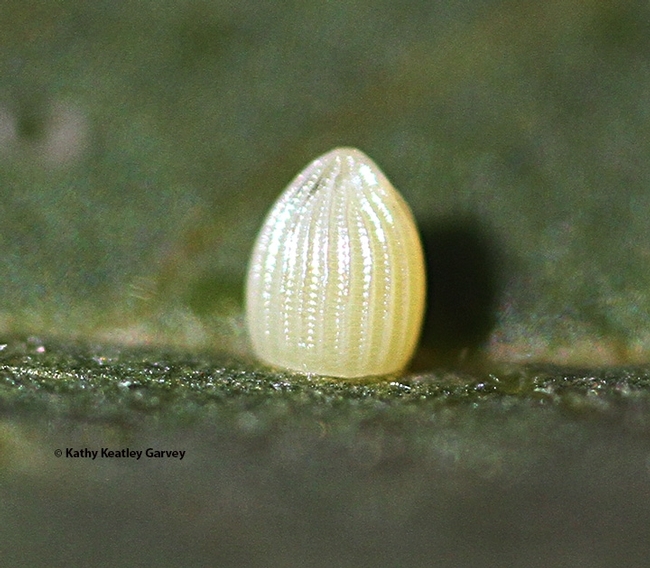
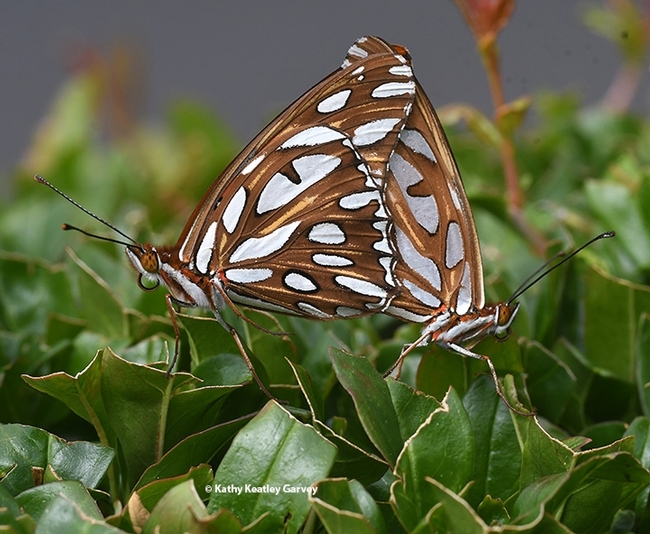
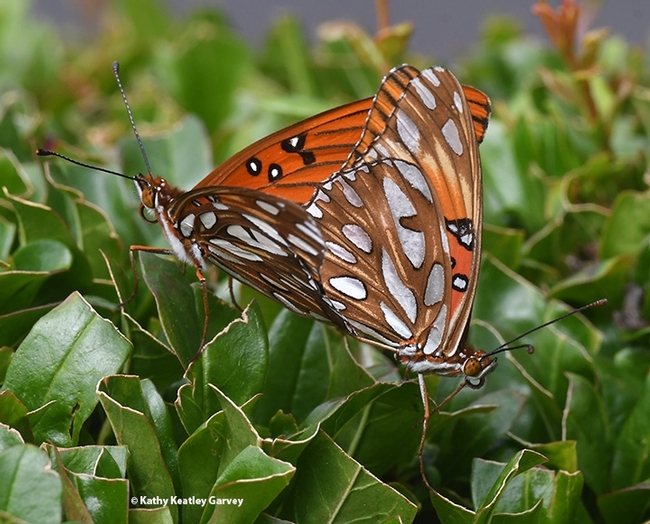
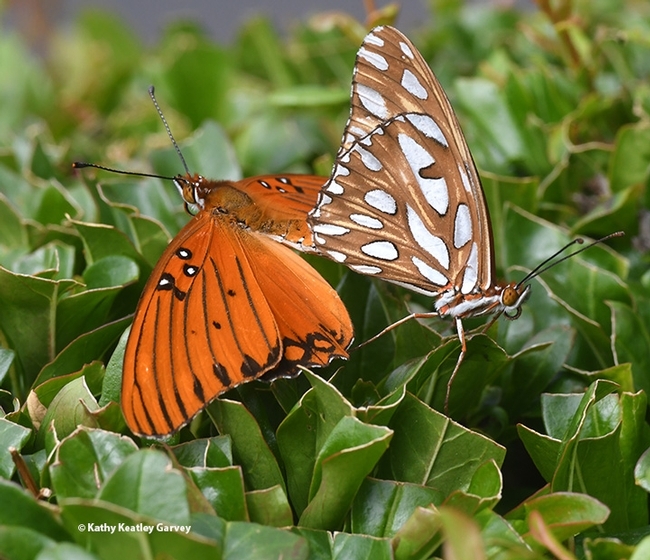
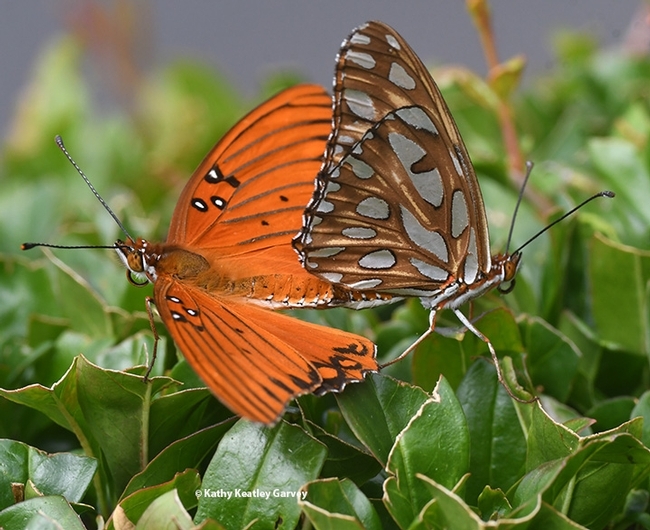
- Author: Kathy Keatley Garvey
Those mighty monarchs haven't graced us with their presence this year (since late January) in our Vacaville, Calif. pollinator garden, but we're waiting for them. The habitat beckons and they will reign.
Meanwhile, it's the beginning of National Pollinator Week, June 21-27, and what better week to pay tribute to all the pollinators out there? Pollinators include not only the honey bees (the poster children), but let's focus on the declining monarchs, Danaus plexippus, and the ever-speedy longhorned bees, Melissodes agilis.
These two species absolutely love the Mexican sunflower, Tithonia rotundifola. The territorial male Melissodes target their fellow pollinators, buzzing them in kamikaze-like maneuvers as they try to dislodge them. Why? As the late Robbin Thorp (1933-2019) distinguished emeritus professor of entomology at UC Davis, used to say: "They're trying to save the flowers for their own species."
As the sun sets, you'll witness a "Boys' Night Out," as the male Melissodes sleep together, cuddled on the Tithonia blossoms while the females return to their nests.
Have you ever taken images of these male bees targeting monarchs? It's like trying to photograph a winged version of Usain Bolt. Faster than a speeding Bolt. More powerful than a locomotive! Able to leap tall flowers in a single bound!
Here's to the first day of National Pollinator Week! And here's to all who help the pollinators by providing habitat for them. They thank you.
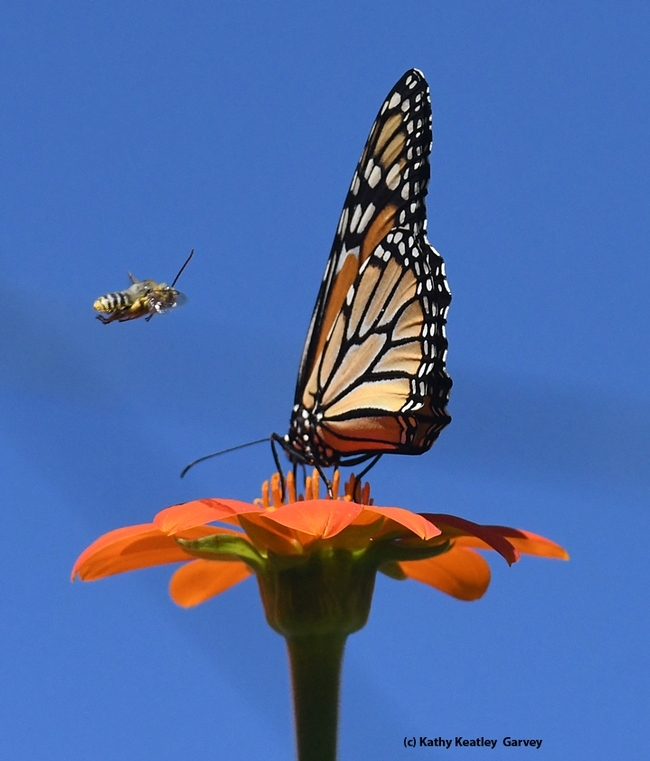

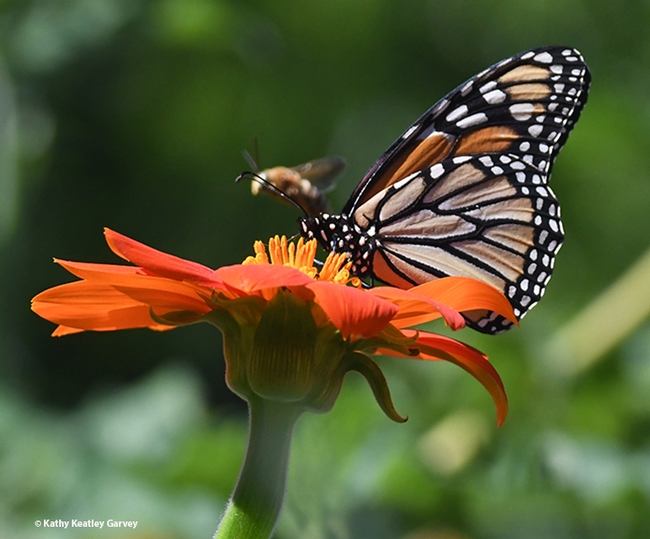
- Author: Kathy Keatley Garvey
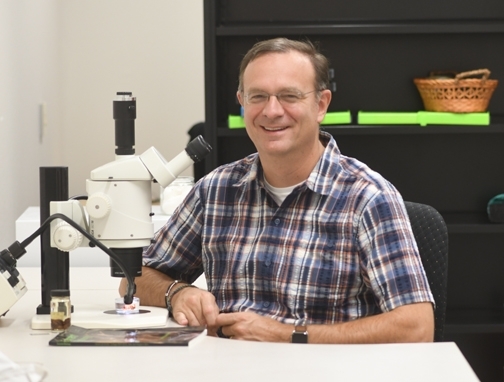
- Shouldn't we be paying more attention to the undiscovered life on this planet while we're exploring other planets for signs of life?
- Shouldn't taxonomy be more valued, appreciated and funded? Shouldn't we be offering more encouragement and training to our students?
Yes, says Jason Bond, the Evert and Marion Schlinger Endowed Chair in Insect Systematics, UC Davis Department of Entomology and Nematology.
The recent podcast, by New Species host L. Brian Patrick, professor of biology at Dakota Wesleyan University, covered the “Taxonomic Impediment." The link:
Bond, who joined the UC Davis faculty in 2018 from Auburn University, Alabama, where he directed the Auburn University Museum of Natural History and chaired the Department of Biological Sciences, focuses his research “primarily on the discovery, conservation, and investigation of the pattern and processes responsible for the diversity of life.”
“My research program has been principally aimed to 1) document biodiversity by discovering and describing new species (and higher taxa, genera and families), 2) identify various dimensions of diversity and those underlying evolutionary processes that generate it, and 3) use these findings to identify threatened or endangered populations and taxa,” he writes on his website. “My organismal expertise centers on terrestrial arthropods (spiders, millipedes, and tenebrionid beetles). Current research projects focus on spider and beetle speciation pattern and process, higher level phylogenomics of millipedes and spiders, and understanding broad-scale patterns of biodiversity and relationship to biogeography, habitat destruction, and climate (contemporary and historical).”

“Typically I think the traditional definition of taxonomy is ‘the science of describing and classifying species,'” Bond told us following the podcast. “I think this definition typically misrepresents taxonomy as a purely descriptive science, which it is not. I think taxonomy might be better defined as ‘the science of species delimitation and classification.' Modern taxonomic species are the outcome of an experiment that tests integrative (i.e., using morphological, genetic, ecological, physiological, etc. ) hypotheses of homology, variation and evolutionary relatedness. These species are serve as hypotheses subject to further testing and refinement as more data (e.g., specimens, genomic, etc.) become available.”
Patrick launched the podcast by describing Bond as “one of my hero arachnologists.”
Bond began by calling attention to the “massive number” of undescribed species in the world. For example, there are about 50,000 described species of spiders, he said, but there are “probably 10 times more than that.” Scores of undescribed species are shelved in insect museums.
When Patrick asked him why there's a taxonomic impediment, Bond commented that “most fundamentally, it's hard work,” and that “very few people are being trained as taxonomists” and very few are hiring them. “If you're a taxonomist working on an obscure group,” you may be the first to be cut from your position, he said.
Bond declared there's a big difference between “identifying arthropods and the science of taxonomy. Someone did the underlying science to allow a person to make that identification.”
“What we're talking about is evolutionary biology,” Bond explained. “We seldom see ads at big universities advertising for a spider taxonomist or a mayfly taxonomist. They want evolutionary biologists. As we train students, we should train them as taxonomists who can clearly sell themselves as evolutionary biologists.”
The National Science Foundation (NSF) used to train students in taxonomy in its PEET (Partnerships for Enhancing Expertise in Taxonomy) program. But PEET is now longer accepting grant proposals.
DNA barcoding, or a method of species identification using a short section of DNA from a specific gene or genes, “is useless in a vacuum,” Bond related. “Someone has to the initial work.”
“If we visited another planet,” Bond said, “and discovered new forms of life, it would be nearly impossible to apply DNA barcoding…there is no silver magic bullet out there to automate species discovery and classification.”
When asked how he would resolve taxonomic impediment, Bond related that more exposure and more funding would certainly help. “We spent $2.9 billion on the Perseverance Mars probe,” Bond said, but in comparison, the annual budget of the NSF's Division of Environmental Biology (which includes grants for taxonomists) amounts to about $155 million. “We spend massive amounts of money exploring other planets than the planet we are on.”
“We're ignoring species extinctions in our own back yard,” Patrick added.
Bond agreed. “While we're trying to find intelligent life on other planets, we are destroying some of the life on our own,” the UC Davis professor said, adding that the next frontier--space exploration—always seems to be more exciting than what we have here.
Bond, who has described more than 100 new taxa--families, genera, species of spiders and millipedes--advocates more attention to taxonomy to “generate the enthusiasm that's out there. We need a hero.”
“If I were independently wealthy, I'd establish a taxonomic foundation or institute where we hire taxonomists to work in-residence,” Bond said, adding that to move science forward, we should bring them in from all over world to work on their regional fauna; and give them the training they need--“at least five years to really work and develop a team.”
